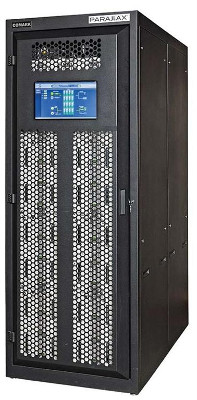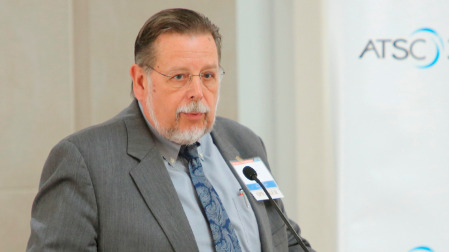SBG, WatchTV Ready For New Rounds Of ATSC 3.0 SFN Tests
BALTIMORE & PORTLAND, ORE.—Second rounds of ATSC 3.0 single frequency network testing are ready to begin on both the East and West Coasts of the United States, but an objection filed with the FCC by a wireless carrier may mean bumps in the road for Sinclair Broadcast Group as it awaits commission approval to expand its Baltimore-Washington, D.C., corridor trial.
Digital modulation and RF specialist TeamCast, OneMedia 3.0 LLC, and Sinclair announced on Sept. 6 phase two of 3.0 SFN tests in Baltimore-Washington. The second phase includes the addition of a Comark Parallax transmitter in Washington to the existing SFN setup, which uses a GatesAir transmitter in D.C. and an Acrodyne IOT transmitter in Baltimore. There’s a catch, however.

The second phase of OneMedia’s ATSC 3.0 SFN test includes the addition of a Hitachi-Comark Parallax transmitter in Washington, D.C., to its existing SFN setup.
“The second channel of our SFN has been delayed due to an objection filed by one of the wireless carriers,” said Mark Aitken, vice president of advanced technology at Sinclair. “The transmitter is installed in Washington and ready to go. But until we get past this impasse, there won’t be a second channel.”
Phase two of the test was to involve the existing transmitters, which operate on Ch. 41, and the new 3.0 transmitter operating on Ch. 43. The setup currently is being fed by a TeamCast ST2L 3.0 exciter from a NOC in Baltimore although the new D.C. transmitter remains off air for the time being.
“We put a lot of time and money into it [ramping up phase two of the SFN text],” said Aitken, who declined to identify the wireless carrier and the reason for the objection.
‘REAL-WORLD EXPERIENCE’
Get the TV Tech Newsletter
The professional video industry's #1 source for news, trends and product and tech information. Sign up below.
In September 2015, the FCC granted the broadcast group Special Temporary Authority to initiate the first phase of its 3.0 SFN tests.
Phase two testing is important to Sinclair because it will allow the group to gain real-world experience with 3.0 channel bonding—something that is a key part of its plan for national deployment of the next-generation television standard.

Mark Aitken, vice president of advanced technology at Sinclair Broadcast Group
“Our [3.0] launch model assumes a minimum of two 6MHz channels being virtually bonded to provide a seamless consumer experience,” said Aitken.
Separately from the Washington-Baltimore SFN test, Sinclair is working with “a large well-known partner” to “build out and deploy SFNs,” he said. “We will soon be announcing a project in a top 10 market where a complete [3.0] multichannel, multisite SFN will be built and deployed for the purposes of putting together consumer market trials.”
The Sinclair SFN deployment has been shortlisted for an IBC 2017 Innovation Award in the Content Distribution Category.
‘LIGHTHOUSE’ TEST
In Portland, Ore., WatchTV has been conducting what company president Greg Herman described as “a large scale 3.0 test” involving five of its stations to—among other things—test the viability of the “lighthouse concept” that would leave one ATSC 1.0 channel on air to serve existing viewers with legacy DTV while at the same time rolling out next-gen TV service.
“We filed at the end of 2016 for an experimental license and received it with some negotiations with the FCC,” explained Herman. “We have the resources to apply multiple channels to it [the WatchTV SFN test], and not just one channel.”
For its test, WatchTV is maintaining one ATSC 1.0 channel and has put four 3.0 channels on air, as well as two gap fillers for two of the next-gen TV channels, he says.

WatchTV is using the TeamCast Vortex II ATSC 3.0 exciter for its Lighthouse tests.
WatchTV, which is using the TeamCast Vortex II ATSC 3.0 exciter, has tested all ATSC 3.0 modulation schemes, including QPSK and QAM constellations, and tested indoor as well as mobile reception, he says. For the mobile test, WatchTV assembled a special transportable 3.0 receiver in a Pelican case, said Herman. “We found out that 3.0 is astoundingly good,” he said.
Indoor off-air reception was equally impressive, he added. “With an indoor antenna, several of the low-power stations [in Portland] operating at 15 kW are non-receivable in 1.0,” he said. “However, with 3.0 at 9kW, signals are eminently receivable.”
WatchTV recently submitted its test data to the commission and filed to renew its experimental license, Herman told TVT. For the second phase of its 3.0 SFN testing, WatchTV may add as many as five more gap fillers, he said.
But even if that were to never happen, Herman said he is sold on ATSC 3.0. “This is a really, really good system. It is impressive, and the people like Dr. [Rich] Chernock [chief science officer of Triveni Digital and chairman of ATSC Technology Group 3] and the rest did a hell of a job.
For a comprehensive list of TV Technology’s ATSC 3.0 coverage, see our ATSC3 silo.
Phil Kurz is a contributing editor to TV Tech. He has written about TV and video technology for more than 30 years and served as editor of three leading industry magazines. He earned a Bachelor of Journalism and a Master’s Degree in Journalism from the University of Missouri-Columbia School of Journalism.

